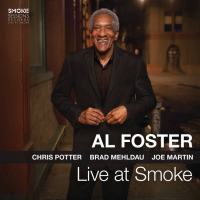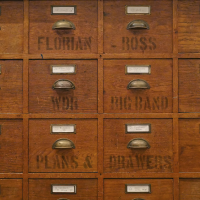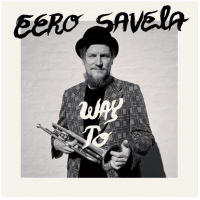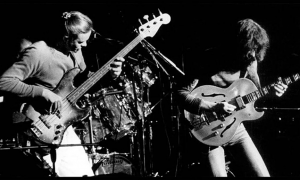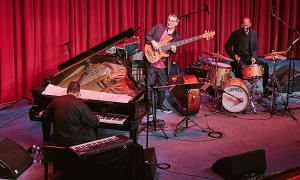Home » Jazz Articles » Profile » Joni Jazz, Part 1
Joni Jazz, Part 1
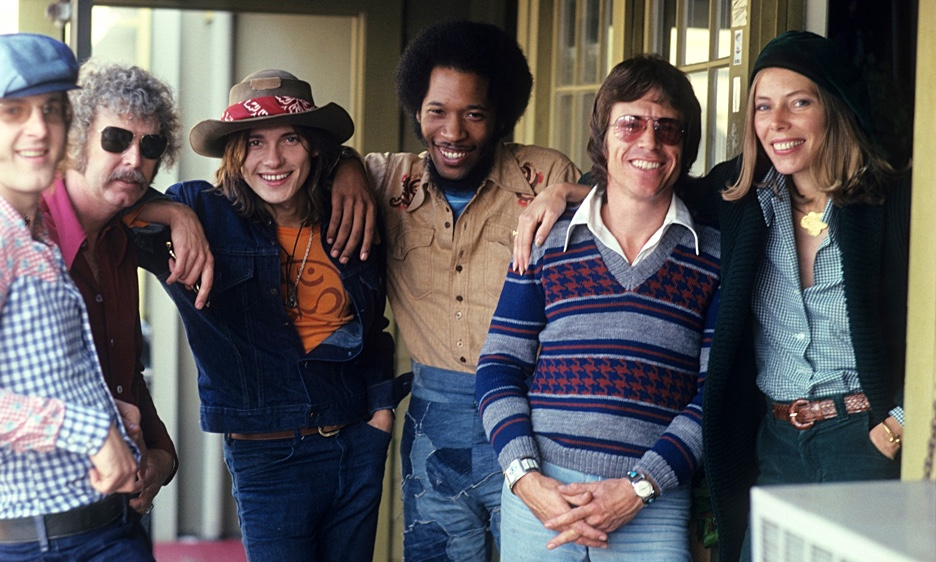
Courtesy Henry Diltz
Mitchell's impulse as a child to visualize disturbing images and exorcise them by drawing them anticipated an artistic aptitude as an adult to channel her emotions into her paintings, poetry and music.
Born Roberta Joan Anderson on November 7, 1943, child of the Canadian Prairie, Joni Mitchell showed signs of becoming an artist at a young age.
In Joni Mitchell in Her Own Words (ECW Press, 2014), a collection of conversations recorded over the years, musician and reporter Malka Marom wondered what inspired her friend's early urge to draw and paint.
Mitchell said her obsession with art was triggered by watching the fire scene in the movie Bambi (Walt Disney Productions, 1942) when she was four or five years old.
Bambi's mother trapped in the fire was horrific to me, and I couldn't exorcise the vision. For days, maybe a week afterwards, I was down on the floor drawing fire and deer running, day after day after day.
"That trauma and anxiety—the forest burning and the animals getting hurt—sparked an obsessive need to exorcise emotion, by drawing it out, drawing it out... I couldn't get the image out of my head. I just had to draw deer running out of flames, draw it and draw it. It was very disturbing to me."
Mitchell's impulse as a child to visualize those disturbing images and exorcise them by drawing them anticipated an artistic aptitude as an adult to channel her emotions into her paintings, poetry and music. Painting remained her existential release, and she alternated songwriting and painting throughout her career. She painted most of her album covers.
Polio
Several years later, Mitchell was caught up in the devastating Canadian polio epidemic of 1953. Neil Young was also afflicted."The third block before the school, I had to sit down and take a little rest because I was aching," Mitchell recalled. "The following day I couldn't get out of bed. I was paralyzed. When they diagnosed it, they shipped me up to a polio colony outside St. Paul's Hospital in Saskatoon."
In his essay, "The Hexagram of the Heavens, the Strings of My Guitar," Matthew Jones wrote:
"The self-described 'broken doll' endured blistering compresses wrapped tight around her paralyzed legs to prevent muscular atrophy and fell asleep each night to the mechanical rhythms of iron lungs."
Mitchell was quarantined along with a six-year-old boy in a trailer annex with a Good King Wenceslas coloring book, which she colored with leftover gentian violet tincture swabs. She recalled singing Christmas carols loudly after they turned the lights out to a small tree her mother, Myrtle, brought her. The boy yelled for her to shut up. "That was my first audience," she recalled.
Painting with Words
Mitchell was released from the hospital and home-schooled by Myrtle for a year. As soon as she was able, Mitchell resumed drawing and painting, and she displayed her art all over school.While she was hanging some of her pictures in a classroom, 7th grade English teacher Arthur Kratzman told her, "If you can paint with a brush, you can paint with words." He later criticized a poem she wrote about horses for his class, though, asking, "How many times have you seen Black Beauty (20th Century Fox, 1946)?" He encouraged her to write from her personal experiences instead.
Or as she would later learn from reading Frederick Nietzsche:
"Of all that is written, I love only what a person hath written with his blood. Write with blood, and thou wilt find that blood is spirit."
Consequently, most of Mitchell's songs are autobiographical.
On the cover of her first album, Song to a Seagull (Reprise, 1968), Mitchell wrote: "This album is dedicated to Mr. Kratzman, who taught me to love words."
Music
As a teenager, Mitchell loved to dance and party, especially in what her mother would consider "the wrong side of town," and entertained her friends by playing a baritone ukulele. But when she tried to play guitar, she confronted the lingering legacy of polio.After buying a Pete Seeger instructional record, Mitchell said: "I went straight to the Elizabeth Cotten picking method. Your thumb went from the sixth string, fifth string, sixth string, fifth string... I couldn't do that, so I ended up playing mostly the sixth string but banging it into the fifth string. So Elizabeth Cotten definitely is an influence; it's me not being able to play like her."
"Mitchell lacked the dexterity necessary to produce complex chords and intricate fingerpicked accompaniment," Jones wrote. "Instead, she relied on an adaptability and resourcefulness that is often underdeveloped in those whose bodies fit smoothly into the prevailing, sustaining environment.
"Mitchell cultivated a novel approach to the guitar comprising many alternate tunings; unorthodox chord voicings; chord sequences more like jazz and classical music than the folk genre with which she is so often (mis)identified; a repertoire of simplified left-hand chord shapes; and an idiosyncratic right-hand technique that incorporates a plectrum, detailed fingerpicking, rhythmic strumming, pizzicato and other effects," Jones wrote. Mitchell called them "chords of inquiry."
Suspended chord video with Joni Mitchell
After being "discovered" by David Crosby in 1967 in a coffee house in Coconut Grove, Florida, and signed to a contract with Reprise Records, Mitchell was slotted into the box labeled "female folksinger/songwriter" along with artists such as Joan Baez and Judy Collins. And once her song Woodstock became the anthem for a generation in 1970, Mitchell was anointed "mother of the hippies" when she lived in Laurel Canyon in Los Angeles.
But the folk singer label was short-lived. "I was only a folk singer for about two years," Mitchell said. "By that time, it wasn't really folk music anymore."
Mitchell was gobsmacked by Bob Dylan's 1965 song, "Positively 4th Street." The directness of his lyric, "You've got a lot of nerve to say you are my friend..." opened a new door for poet/singers and left a profound impression on Mitchell. "I thought, 'Oh my God, you can write about anything in songs.' It was like a revelation to me."
"From that moment on," according to Far Out Magazine, "she dared to be bold, forgo the old folk standards and harness the power of unfettered individual sincerity."
Joni Jazz
"My first five records, it's basically me and my overdubs," Mitchell said. "There's a few guests on there but they're used very minimally, like maybe the drums coming in on the last verse of the tag out. There isn't very much because I really didn't like the sound of the drums and the bass. The drums were dead (then) and they had a little flat sound, and I like a resonant slack tom like Gene Krupa. I like a bass that you could hear three blocks away."This went on and on and on for five, six years, until one guy said to me, 'Joni, you're gonna have to play with jazz musicians.' So I started going to the jazz clubs and I found Tom Scott and The LA Express, and that's how I came to them on Court and Spark (Asylum, 1974)."
Mitchell heard the LA Express play at the Baked Potato in Los Angeles. The Express was a fusion jazz group led by horn player Tom Scott, drummer John Payne Guerin and bassist Max Bennett, along with percussionist Bobbye Hall, guitarist Robben Ford and members of The Jazz Crusaders: Larry Carlton, Joe Sample and Wilton Felder. They were much in demand as session musicians.
Mitchell asked Scott, "Do you think the guys might want to play a couple of tunes on my new album?" Scott reckoned that they would. It was an excellent business decision for them both. The LA Express played on her next four albums, including the live record, Miles of Aisles (Asylum, 1974).
"It took me six years to find a band that inflamed me to that degree that I wanted to be part of them in a project, and that already had a working relationship member to member, in which I could just sort of fit into and where I felt that they would be sensitive to my music," Mitchell said.
Raised on Robbery
In 1974, Mitchell toured with the LA Express to support Court and Spark, their first album together. Here they perform "Raised on Robbery" in London with Robben Ford on electric guitar and Roger Kellaway on piano.In this video, the LA Express backs Mitchell on her song "Free Man in Paris" from Court and Spark. It's about agent and recording industry executive David Geffen. Geffen had asked Mitchell to write a hit song and "You Turn Me On I'm a Radio" was her response.
Mitchell solo and with the LA Express on "People's Parties," "The Same Situation," and "Help Me."
Celebrity references abound
Mitchell's studio albums with the LA Express—Court and Spark, The Hissing of Summer Lawns (Asylum, 1975) and Hejira (Asylum, 1976)—plus their live double album, Miles of Aisles, were relatively well received. Court and Spark sold more than two million records, a career high.
But as Mitchell continued to grow as an artist and felt the urge to experiment as a musician, she sensed something was still missing.
"Even with that band, Max (Bennett) is a great bassist, but still, he had dead strings, John (Guerin) had a pillow in his kit drum, and I wanted a more resonant sound, and I couldn't get them to do it.
"What I found out after the fact was that when you went from 45s to 33 1/3 albums, you could only get on an album between 18 and 22 minutes to a side. So I could get from 40 to approximately 44 to 48 minutes on both sides.
"Well, I had long songs. And the record company wanted 10 songs. So what happened on the 33 1/3 album was the treble is a skinnier groove, but the bass is a big fat groove and it takes up more space, so the bigger the bass sound, the less time you can get on the side. And so, in order to accommodate that, the style developed that you deaden the sound of the percussion."
For her next band, Mitchell looked to one of her jazz heroes.
Tags
Profile
Joni Mitchell
Chuck Lenatti
Neil Young
Pete Seeger
Elizabeth Cotton
David Crosby
Joan Baez
Judy Collins
Bob Dylan
Gene Krupa
Tom Scott
The LA Express
John Guerin
Max Bennett
Bobbye Hall
Robben Ford
The Jazz Crusaders
Larry Carlton
Joe Sample
Wilton Felder
PREVIOUS / NEXT
Support All About Jazz
 All About Jazz has been a pillar of jazz since 1995, championing it as an art form and, more importantly, supporting the musicians who make it. Our enduring commitment has made "AAJ" one of the most culturally important websites of its kind, read by hundreds of thousands of fans, musicians and industry figures every month.
All About Jazz has been a pillar of jazz since 1995, championing it as an art form and, more importantly, supporting the musicians who make it. Our enduring commitment has made "AAJ" one of the most culturally important websites of its kind, read by hundreds of thousands of fans, musicians and industry figures every month.






